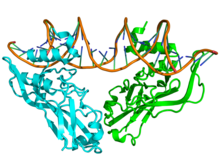T-box
| T-box | |||||||||||
|---|---|---|---|---|---|---|---|---|---|---|---|
 Crystallographicstructure of theTBX3protein dimer (cyan and green) complexed with DNA (brown) based on thePDB:1h6f coordinates. | |||||||||||
| Identifiers | |||||||||||
| Symbol | T-box | ||||||||||
| Pfam | PF00907 | ||||||||||
| InterPro | IPR001699 | ||||||||||
| PROSITE | PS50252 | ||||||||||
| SCOP2 | 1xbr/SCOPe/SUPFAM | ||||||||||
| |||||||||||
T-boxrefers to a group oftranscription factorsinvolved inembryoniclimbandheartdevelopment.[1]Every T-box protein has a relatively large DNA-binding domain, generally comprising about a third of the entire protein that is both necessary and sufficient for sequence-specific DNA binding. All members of the T-box gene family bind to the "T-box", a DNA consensus sequence of TCACACCT.[2]
Members[edit]
T-boxes are especially important to the development of embryos, found inzebrafishoocyte by Bruce et al 2003 andXenopus laevisoocyte by Xanthos et al 2001. They are alsoexpressedin later stages, including adultmouseandrabbitstudied by Szabo et al 2000.[3]
Mutations in the first one found caused short tails in mice, and thus the protein encoded was namedbrachyury,Greek for "short-tail". In mice this gene is namedTbxt,and in humans it is namedTBXT.[4][5]Brachyury has been found in allbilateriananimals that have been screened, and is also present in thecnidaria.[6]
The mouseTbxtgene was cloned[7]and found to be a 436 amino acid embryonic nucleartranscription factor.The protein brachyury binds to the T-box through a region at its N-terminus.
Protein activity[edit]
The encoded proteins ofTBX5andTBX4play a role inlimb development,and play a major role inlimb budinitiation specifically.[8]For instance, in chickens TBX4 specifies hindlimb status while Tbx5 specifies forelimb status.[9]The activation of these proteins byHox genesinitiates signaling cascades that involve theWnt signaling pathwayandFGF signalsin limb buds.[8]Ultimately, TBX4 and TBX5 lead to the development ofapical ectodermal ridge (AER)andzone of polarizing activity (ZPA)signaling centers in the developing limb bud, which specify the orientation growth of the developing limb.[8]Together, TBX5 and TBX4 play a role in patterning the soft tissues (muscles and tendons) of the musculoskeletal system.[10]
Defects[edit]
In humans, and some other animals, defects in theTBX5gene expressionare responsible forHolt–Oram syndrome,which is characterized by at least one abnormalwrist bone.Other arm bones are almost always affected, though the severity can vary widely, from complete absence of a bone, to only a reduction in bone length.[11][12]Seventy-five percent of affected individuals also haveheart defects,most often there is no separation between the left and rightventricleof theheart.[13]
TBX3is associated withulnar–mammary syndromein humans, but is also responsible for the presence or absence ofdun colorin horses, and has no deleterious effects whether expressed or not.[14]
T-box genes[edit]
Genes encoding T-box proteins include:
See also[edit]
References[edit]
- ^Wilson V, Conlon FL (2002)."The T-box family".Genome Biology.3(6): REVIEWS3008.doi:10.1186/gb-2002-3-6-reviews3008.PMC139375.PMID12093383.
- ^Müller, CW; Herrmann, BG (23 October 1997). "Crystallographic structure of the T domain-DNA complex of the Brachyury transcription factor".Nature.389(6653): 884–8.Bibcode:1997Natur.389..884M.doi:10.1038/39929.PMID9349824.S2CID13138577.
- ^Naiche, L.A.; Harrelson, Zachary; Kelly, Robert G.; Papaioannou, Virginia E. (2005-12-01). "T-Box Genes in Vertebrate Development".Annual Review of Genetics.39(1).Annual Reviews:219–239.doi:10.1146/annurev.genet.39.073003.105925.ISSN0066-4197.PMID16285859.
- ^"Entrez Gene: T".
- ^Edwards YH, Putt W, Lekoape KM, Stott D, Fox M, Hopkinson DA, Sowden J (March 1996)."The human homolog T of the mouse T(Brachyury) gene; gene structure, cDNA sequence, and assignment to chromosome 6q27".Genome Research.6(3): 226–33.doi:10.1101/gr.6.3.226.PMID8963900.
- ^Scholz CB, Technau U (January 2003). "The ancestral role of Brachyury: expression of NemBra1 in the basal cnidarian Nematostella vectensis (Anthozoa)".Development Genes and Evolution.212(12): 563–70.doi:10.1007/s00427-002-0272-x.PMID12536320.S2CID25311702.
- ^Herrmann BG, Labeit S, Poustka A, King TR, Lehrach H (February 1990). "Cloning of the T gene required in mesoderm formation in the mouse".Nature.343(6259): 617–22.Bibcode:1990Natur.343..617H.doi:10.1038/343617a0.PMID2154694.S2CID4365020.
- ^abcTickle C (October 2015)."How the embryo makes a limb: determination, polarity and identity".Journal of Anatomy.227(4): 418–30.doi:10.1111/joa.12361.PMC4580101.PMID26249743.
- ^Rodriguez-Esteban C, Tsukui T, Yonei S, Magallon J, Tamura K, Izpisua Belmonte JC (April 1999). "The T-box genes Tbx4 and Tbx5 regulate limb outgrowth and identity".Nature.398(6730): 814–8.Bibcode:1999Natur.398..814R.doi:10.1038/19769.PMID10235264.S2CID4330287.
- ^Hasson P, DeLaurier A, Bennett M, Grigorieva E, Naiche LA, Papaioannou VE, Mohun TJ, Logan MP (January 2010)."Tbx4 and tbx5 acting in connective tissue are required for limb muscle and tendon patterning".Developmental Cell.18(1): 148–56.doi:10.1016/j.devcel.2009.11.013.PMC3034643.PMID20152185.
- ^"Holt–Oram syndrome".Genetics Home Reference.U.S. National Library of Medicine. June 2014.Retrieved18 April2018.
- ^McDermott DA, Fong JC, Basson CT. Holt–Oram Syndrome. 2004 Jul 20 [Updated 2015 Oct 8]. In Adam MP, Ardinger HH, Pagon RA, et al., editors. GeneReviews® [Internet]. Seattle (WA): University of Washington, Seattle; 1993-2018. Available from:https:// ncbi.nlm.nih.gov/books/NBK1111/
- ^Bossert, T; Walther, T; Gummert, J; Hubald, R; Kostelka, M; Mohr, FW (October 2002). "Cardiac malformations associated with the Holt–Oram syndrome—report on a family and review of the literature".The Thoracic and Cardiovascular Surgeon.50(5): 312–4.doi:10.1055/s-2002-34573.PMID12375192.S2CID19665997.
- ^Imsland F, McGowan K, Rubin CJ, Henegar C, Sundström E, Berglund J, et al. (February 2016)."Regulatory mutations in TBX3 disrupt asymmetric hair pigmentation that underlies Dun camouflage color in horses".Nature Genetics.48(2): 152–8.doi:10.1038/ng.3475.PMC4731265.PMID26691985.
- "A horse of a different color: Genetics of camouflage and the dun pattern".ScienceDaily(Press release). December 21, 2015.
Further reading[edit]
- Meisler MH (1997)."Mutation watch: mouse brachyury (T), the T-box gene family, and human disease".Mammalian Genome.8(11): 799–800.doi:10.1007/s003359900581.hdl:2027.42/42140.PMID9337389.S2CID12617264.
External links[edit]
- T-Box+Domain+Proteinsat the U.S. National Library of MedicineMedical Subject Headings(MeSH)
